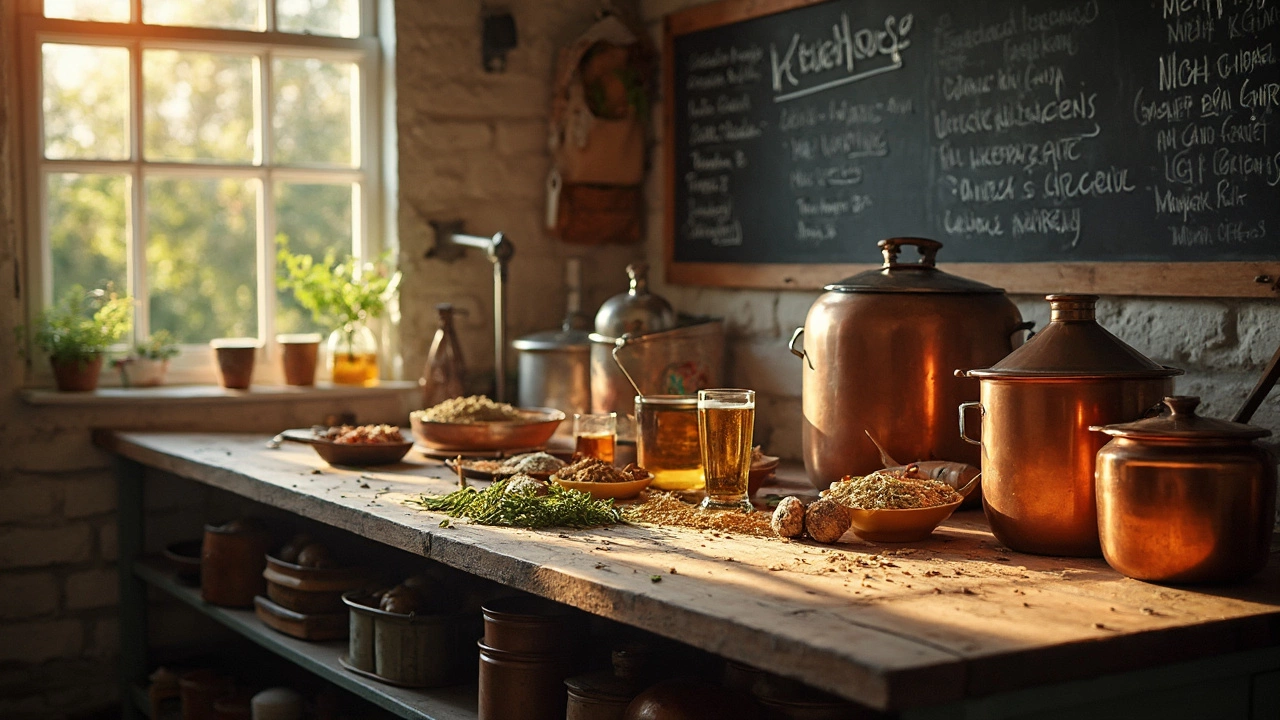If you've ever wondered whether making your own beer could save you money, you're not alone. It's a question many beer lovers ask, especially when faced with rising costs at the liquor store. The reality is, home brewing isn't just about drinking beer—it's a hobby, a science experiment, and a potential money-saver rolled into one.
Let's start with what you'll need. The initial setup for home brewing does come with an upfront cost. Home brewing kits can range from reasonably priced to quite high-end, but most beginners won't need to splash out too much cash. A basic kit with fermentation buckets, cappers, and ingredients will run you anywhere from $50 to $150 AUD.
Now, think about the ingredients. The basics include malt, hops, yeast, and water. But here's the game-changer: buying in bulk. When you buy these essentials in larger quantities, the price per batch drops significantly. You could be looking at as little as $1 to $2 per bottle, which beats most retail prices.
- The Initial Investment: What You Need
- Cost Breakdown: Ingredients and Supplies
- Economies of Scale: Brewing in Bulk
- Quality vs. Cost: Is It Worth It?
- Tips to Save Money While Brewing
The Initial Investment: What You Need
Before you start crafting your very own brews, you'll need to invest in a few essential pieces of equipment. While the initial cost might seem a bit hefty, think of it as laying the foundation for countless batches of beer that could save you money in the long run.
Basic Equipment
The first thing you'll want is a good home brewing kit. For beginners, these home brewing kits can be a total lifesaver. They typically include a fermenting bucket, an airlock, a stirring spoon, a syphon, and a capper. Prices start at about $50 AUD and can go up to $200 AUD for more comprehensive sets.
Here's a quick rundown of the essential gear:
- Fermenting Bucket: A large, food-grade plastic or glass container equipped with an airlock to let gases escape during fermentation without letting air in.
- Syphon: This handy tube helps transfer beer from one container to another without disturbing sediment.
- Capper: Used for sealing your bottles once the beer is ready. Just make sure you have plenty of caps!
"Investing in quality equipment from the start can save money and frustration in the long run." - Home Brewer's Bible
Optional Upgrades
If you're serious about your brewing, there are a few optional gadgets worth considering:
- Carboy: Glass carboys are great for secondary fermentation and can help produce clearer beer.
- Hydrometer: Used to measure the specific gravity of your brew, letting you track fermentation progress and calculate alcohol content.
- Thermometer: Keeping an eye on your brew's temperature is crucial for maintaining quality.
While there's an upfront cost, this investment is like your golden ticket into the world of DIY beer. Plus, it comes with the satisfaction of sipping something you made yourself, with a taste that's uniquely yours! So, gear up and get ready to explore your brewing journey.
Cost Breakdown: Ingredients and Supplies
Once you've got your basic kit, it's time to look at what actually goes into making a DIY beer. The ingredients are where you can really make or break the bank, but with a *thrifty approach*, you’ll find some savings might surprise you.
The main components you'll need are malt, hops, yeast, and water. Malt extracts, either liquid or dry, are your sugar supply, and you can find them for around $10 to $20 AUD per kilogram, which usually covers one batch of about 20 liters. Hops add flavor and aroma, and they’re not too pricey—expect to pay about $2 to $5 AUD per 100 grams.
Yeast and Water
Yeast is your dynamo behind fermentation, and luckily, it's affordable. A packet costing about $2 to $5 AUD is enough for a batch. As for water, good news: tap water often works just fine, though you might want to filter it if it's not the best in your area.
A well-known home brewing expert, John Palmer, puts it simply: "The equipment and ingredients for a batch may cost as much as a case of beer, but what's in the box is your tuition."
Other Supplies
Beyond the essentials, you'll also need sanitizers to keep everything clean and prevent unwanted bacteria from joining the party. An effective sanitizer is usually available for under $10 AUD and will last several batches.
Also, consider bottling supplies. Secondhand bottles are an option, and caps are fairly cheap. Or, you could go the extra mile with a kegging setup if you're serious about brewing regularly.
Crunching the Numbers
While the initial cost might sound a tad steep, remember—it's all about that sweet economy of scale. If you’re brewing regularly, the costs per brew drop massively. Here’s a quick look:
| Item | Cost (AUD) |
|---|---|
| Malt | $10–$20 per kg |
| Hops | $2–$5 per 100g |
| Yeast | $2–$5 per packet |
| Sanitizer | Under $10 |
Take a look at your next six-pack purchase and compare. Brewing your own might cost more initially, but over time, those pints will taste even sweeter, both to your pallet and your wallet.

Economies of Scale: Brewing in Bulk
When it comes to home brewing, one way to save significant dough is by scaling up your production. Bigger batches can mean better savings, and here's how that plays out. Aiming for larger quantities allows you to spread the cost of ingredients—like malt and hops—over more bottles, trimming down the cost per bottle.
Let's break it down. Say you purchase malt in a 25 kg bag instead of a 1 kg pack. The price per kilo naturally drops, saving you a chunk over time. The same theory applies to hops and yeast, where larger packs give you more bang for your buck. You end up getting more beer out of each brewing session for less cash spent on ingredients per litre.
Advantages of Brewing in Bulk
- Reduced cost per litre: Larger quantities of ingredients come at a cheaper per-unit price.
- Less frequent purchases: Stocking up means fewer shopping trips, saving you time and effort.
- Enhanced batch consistency: Bigger batches provide more stable conditions, potentially improving the overall quality of your brew.
An interesting tidbit here: Many home brewers notice a 30% decrease in cost per bottle when brewing in bulk compared to smaller batches. These savings can stack up over time, making your favourite craft beer creation even more cost-effective.
Thinking of storage? You'll want to consider space for fermenting and storing the extra bottles. You might need to get creative with your garage or spare room, but it's usually well worth it for the savings and the sheer satisfaction of a well-stocked beer shelf.
In short, if you've got the room and the dedication, brewing in bulk is a smart move for any budding home brewer looking to make their DIY beer passion a little friendlier on the wallet.
Quality vs. Cost: Is It Worth It?
Jumping into the world of making your own beer raises a big question: is home brewing kits delivering the quality you’re expecting, and is it worth the cost?
First off, if you’re a fan of experimenting with flavors and styles, home brewing is a brilliant option. You control every part of the process, tailoring each batch to your taste. Commercial beers can't compete with that level of customization. Want a mango-infused IPA or a chocolate stout? It’s all up to you.
Quality: Putting Flavor First
Your brew's quality can sometimes match or even beat commercial brews, but it hinges on using the right ingredients and sticking to a consistent method. Good yeast and fresh hops can turn a standard brew into something special. Plus, as you get better, so does your beer.
Cost: Getting the Best Bang for Your Buck
Now let's talk numbers. While initial costs might set you back a bit, the long-term savings add up. A six-pack of commercial beer in Australia can set you back around $15 AUD or more. But a home-brewed equivalent usually costs half as much per bottle.
Is It Worth It?
If your goal is to save money, it’s worth considering how often you drink. The more you brew, the quicker you make up for the initial outlay. And if you’re someone who prizes experimenting with flavors over just cracking open a store-bought can, the value is undeniable.
When weighing cost-effective brewing against quality, home brewing often comes out on top, offering not just savings, but a unique and enjoyable experience. Whether you’re brewing for budget, hobby, or both, the effort can be well worth the investment.

Tips to Save Money While Brewing
Want to brew and save a buck at the same time? It's easier than you think, and a few smart strategies can make your home brewing kits even more cost-effective. Let's dive into the practical stuff that can help you pinch pennies without sacrificing your frothy concoction's quality.
Buy in Bulk
Here's a golden rule for saving money in the DIY beer world: the more you buy at once, the less you pay per batch. This applies to malt, hops, and yeast—the essentials of any brew. If you're planning to stick with brewing long-term, consider investing in a bulk-buying group through online brewing forums.
Keep It Simple with Recipes
As tempting as it is to get fancy, sticking to a basic recipe—especially as a beginner—can save cash. Exotic flavors might sound fun, but they often mean pricey, hard-to-find ingredients. As your skills grow, you can gradually experiment without breaking the bank.
Reuse Your Bottles
Reuse is your friend. Wash and sterilize store-bought beer bottles instead of buying new ones. It’s good for your wallet and the environment. Just remember, proper sanitation is key to avoid any contamination.
Use Alternative Energy Sources for Heating
If you're serious about DIY beer and doing multiple batches, consider alternative energy sources like a solar setup to heat your brewing elements. While it may seem a big investment upfront, solar heating can cut down electricity costs over time.
Check Out Local Ingredient Markets
Instead of heading straight to speciality shops, think local. Farmers' markets might have fresh, affordable ingredients that add flair to your creations. Plus, supporting local growers feels good too.
Stay Efficient with Your Equipment
Do regular checks and maintenance on your equipment. Efficiency leads to less waste, making your process a lot friendlier for the wallet. A few tweaks here and ongoing care there can stop any unnecessary expenses piling up.
Following these tips can help keep your brewing budget in check, allowing more room for experimentation and enjoyment along the way.


